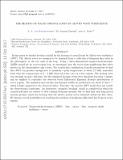Files in this item
The heating of solar coronal loops by Alfvèn wave turbulence
Item metadata
| dc.contributor.author | van Ballegooijen, A. A. | |
| dc.contributor.author | Asgari-Targhi, M. | |
| dc.contributor.author | Voss, A. | |
| dc.date.accessioned | 2017-12-05T17:30:06Z | |
| dc.date.available | 2017-12-05T17:30:06Z | |
| dc.date.issued | 2017-10-30 | |
| dc.identifier | 251423842 | |
| dc.identifier | 3fea4901-473d-445b-9b4b-94db670c6aec | |
| dc.identifier | 000414073800002 | |
| dc.identifier | 85042300242 | |
| dc.identifier.citation | van Ballegooijen , A A , Asgari-Targhi , M & Voss , A 2017 , ' The heating of solar coronal loops by Alfvèn wave turbulence ' , Astrophysical Journal , vol. 849 , no. 1 , 46 . https://doi.org/10.3847/1538-4357/aa9118 | en |
| dc.identifier.issn | 0004-637X | |
| dc.identifier.other | ORCID: /0000-0002-8053-2175/work/38124084 | |
| dc.identifier.uri | https://hdl.handle.net/10023/12261 | |
| dc.description | This project was supported under contract NNM07AB07C from NASA to the Smithsonian Astrophysical Observatory (SAO) and contract SP02H1701R from Lockheed Martin Space and Astrophysics Laboratory (LMSAL) to SAO. | en |
| dc.description.abstract | In this paper we further develop a model for the heating of coronal loops by Alfvèn wave turbulence (AWT). The Alfvèn waves are assumed to be launched from a collection of kilogauss flux tubes in the photosphere at the two ends of the loop. Using a three-dimensional magneto-hydrodynamic (MHD) model for an active-region loop, we investigate how the waves from neighboring flux tubes interact in the chromosphere and corona. For a particular combination of model parameters we find that AWT can produce enough heat to maintain a peak temperature of about 2.5 MK, somewhat lower than the temperatures of 3 – 4 MK observed in the cores of active regions. The heating rates vary strongly in space and time, but the simulated heating events have durations less than 1 minute and are unlikely to reproduce the observed broad Differential Emission Measure distributions of active regions. The simulated spectral line non-thermal widths are predicted to be about 27 km s−1, which is high compared to the observed values. Therefore, the present AWT model does not satisfy the observational constraints. An alternative “magnetic braiding” model is considered in which the coronal field lines are subject to slow random footpoint motions, but we find that such long period motions produce much less heating than the shorter period waves launched within the flux tubes. We discuss several possibilities for resolving the problem of producing sufficiently hot loops in active regions. | |
| dc.format.extent | 3676607 | |
| dc.language.iso | eng | |
| dc.relation.ispartof | Astrophysical Journal | en |
| dc.subject | Magnetohydrodynamics (MHD) | en |
| dc.subject | Sun: corona | en |
| dc.subject | Sun: magnetic fields | en |
| dc.subject | Turbulence | en |
| dc.subject | Waves | en |
| dc.subject | QB Astronomy | en |
| dc.subject | QC Physics | en |
| dc.subject | NDAS | en |
| dc.subject.lcc | QB | en |
| dc.subject.lcc | QC | en |
| dc.title | The heating of solar coronal loops by Alfvèn wave turbulence | en |
| dc.type | Journal article | en |
| dc.contributor.institution | University of St Andrews. School of Computer Science | en |
| dc.identifier.doi | https://doi.org/10.3847/1538-4357/aa9118 | |
| dc.description.status | Peer reviewed | en |
| dc.identifier.url | https://arxiv.org/abs/1710.05074 | en |
This item appears in the following Collection(s)
Items in the St Andrews Research Repository are protected by copyright, with all rights reserved, unless otherwise indicated.

